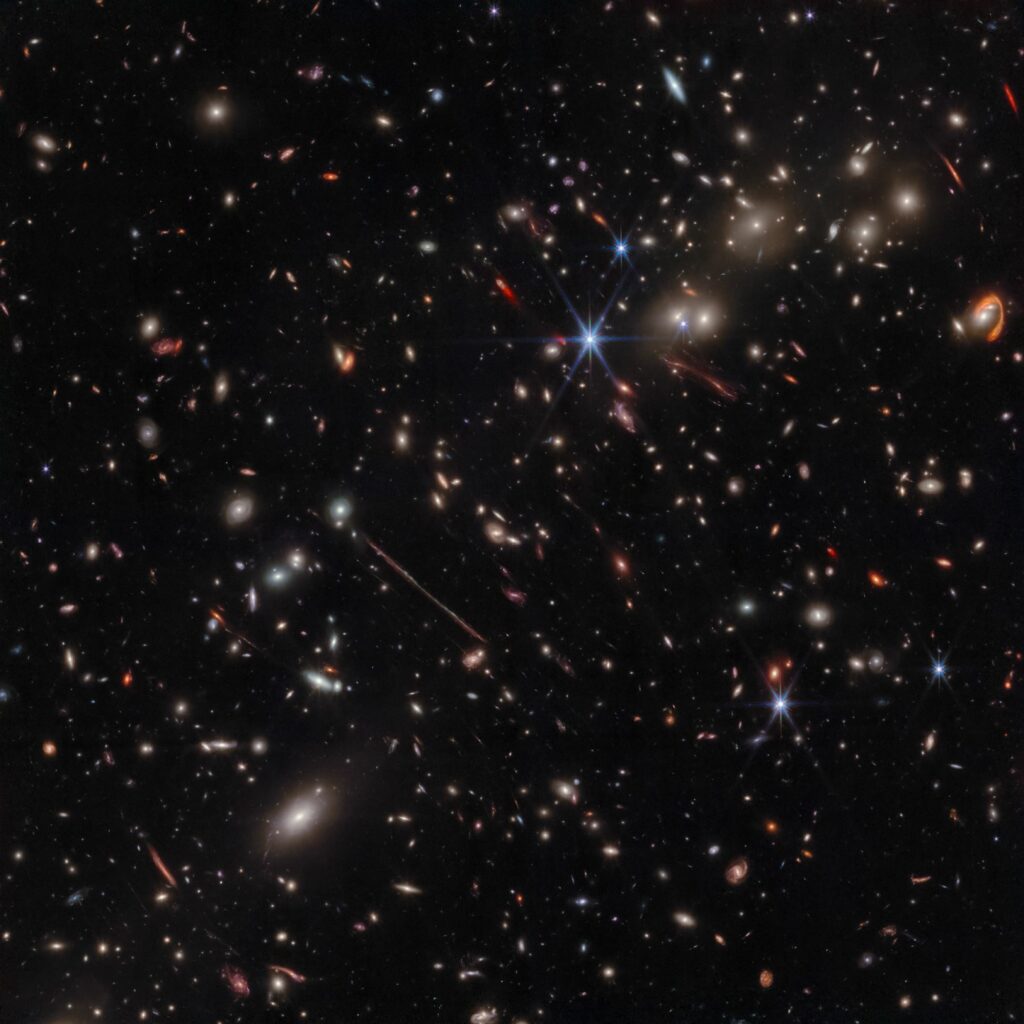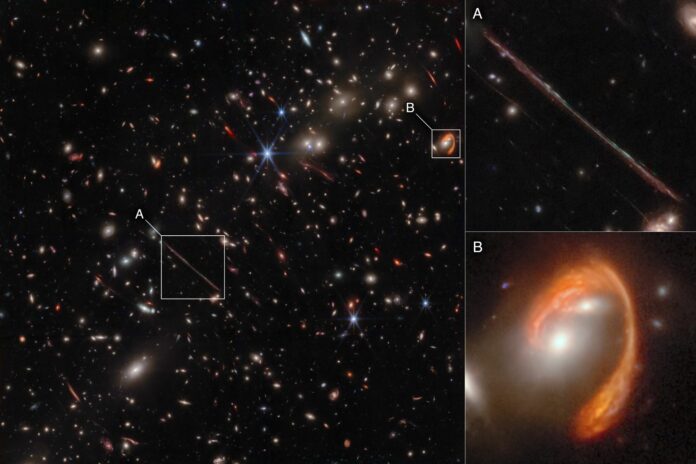NASA’s James Webb Space Telescope recently captured an image of the El Gordo galaxy cluster. The image shows distant and dusty objects that were previously unseen. What’s more, it offers a bounty of fresh science.
The cluster ‘El Gordo’ is the most massive cluster known to exist when the universe was 6.2 billion years old- containing hundreds of galaxies. Also known as ACT-CL J0102-4915 or SPT-CL J0102-4915, or The Fat One, the cluster acts as a natural, cosmic magnifying glass through gravitational lensing.
Due to its powerful gravity, the light of the objects (lying behind it) bends and distorts- more like an eyeglass lens. This lensing, thereby, boosts the brightness and magnifies the sizes of distant galaxies.
One of the most noticeable aspects in the image of El Gordo is a dazzling arc shown in red at the upper right. The light from this galaxy, nicknamed “El Anzuelo” (The Fishhook) by one of Frye’s students, took 10.6 billion years to reach Earth. Its unusual red color is caused by dust reddening within the galaxy and cosmological redshift caused by its vast distance.
By compensating for lensing distortions, the scientists discovered that the background galaxy is disk-shaped but just 26,000 light-years across – approximately one-fourth the size of the Milky Way. They also investigated the history of star formation in the galaxy, discovering that star formation was already fast declining in the galaxy’s core, a process known as quenching.
Patrick Kamieneski of Arizona State University said, “We were able to carefully dissect the shroud of dust that envelops the galaxy center where stars are actively forming. Now, with Webb, we can easily peer through this thick curtain of dust, allowing us to see firsthand the assembly of galaxies from the inside out.”

A long, pencil-thin line to the left of the center is another noticeable feature in the Webb image. It is another lensed background galaxy, “La Flaca” (The Thin One), whose light took approximately 11 billion years to reach Earth.
Not far from La Flaca is another lensed galaxy. When the researchers looked closely at that galaxy, they discovered a single red giant star named Quyllur, the Quechua word for star. Quyllur is the first individual red giant star observed beyond 1 billion light-years from Earth.
The team also identified five multiply lensed galaxies, which appear to be a baby galaxy cluster forming about 12.1 billion years ago. Another dozen candidate galaxies may also be part of this distant cluster.
Additional data could confirm that there are 17 members of this cluster, offering evidence of the formation of a new galaxy cluster just over a billion years after the big bang.
The final paper reports on ultra-diffuse galaxies- objects scattered throughout the El Gordo cluster. They have their stars widely spread out across space. The team identified objects whose light traveled 7.2 billion years to reach us.
Timothy Carleton of Arizona State University said, “We examined whether the properties of these galaxies are any different than the ultra-diffuse galaxies we see in the local universe, and we see some differences. In particular, they are bluer, younger, more extended, and evenly distributed throughout the cluster. This suggests that living in the cluster environment for the past 6 billion years has significantly affected these galaxies.”
Rogier Windhorst of Arizona State University, principal investigator of the PEARLS program, said, “Gravitational lensing was predicted by Albert Einstein more than 100 years ago. In the El Gordo cluster, we see the power of gravitational lensing in action. The PEARLS images of El Gordo are out-of-this-world beautiful. And, they have shown us how Webb can unlock Einstein’s treasure chest.”
Journal References:
- Brenda L. Frye, Massimo Pascale, Nicholas Foo, Reagen Leimbach, Nikhil Garuda, Paulina Soto Robles, Jake Summers, Carlos Diaz, Patrick Kamieneski, Lukas J. Furtak, Seth H. Cohen, Jose Diego, Benjamin Beauchesne, Rogier A. Windhorst, S. P. Willner, Anton M. Koekemoer, Adi Zitrin, Gabriel Caminha, Karina I. Caputi, Dan Coe, Christopher J. Conselice, Liang Dai, Hervé Dole, Simon P. Driver, Norman A. Grogin, Kevin Harrington, Rolf A. Jansen, Jean-Paul Kneib, Matt Lehnert, James Lowenthal, Madeline A. Marshall, Felipe Menanteau, Belén Alcalde Pampliega, Nor Pirzkal, Mari Polletta, Johan Richard, Aaron Robotham, Russell E. Ryan, Michael J. Rutkowski, Christóbal Sifón, Scott Tompkins, Daniel Wang, Haojing Yan, Min S. Yun. The JWST PEARLS View of the El Gordo Galaxy Cluster and the Structure It Magnifies. The Astrophysical Journal, 2023; 952 (1): 81 DOI: 10.3847/1538-4357/acd929
- Patrick S. Kamieneski, Brenda L. Frye, Massimo Pascale, Seth H. Cohen, Rogier A. Windhorst, Rolf A. Jansen, Min S. Yun, Cheng Cheng, Jake S. Summers, Timothy Carleton, Kevin C. Harrington, Jose M. Diego, Haojing Yan, Anton M. Koekemoer, Christopher N. A. Willmer, Andreea Petric, Lukas J. Furtak, Nicholas Foo, Christopher J. Conselice, Dan Coe, Simon P. Driver, Norman A. Grogin, Madeline A. Marshall, Nor Pirzkal, Aaron S. G. Robotham, Russell E. Ryan Jr., Scott Tompkins. Are JWST/NIRCam color gradients in the lensed z=2.3 dusty star-forming El Anzuelo due to central dust attenuation or inside-out galaxy growth? Submitted to arXiv, 2023 DOI: 10.48550/arXiv.2303.05054
- J. M. Diego, A. K. Meena, N. J. Adams, T. Broadhurst, L. Dai, D. Coe, B. Frye, P. Kelly, A. M. Koekemoer, M. Pascale, S. P. Willner, E. Zackrisson, A. Zitrin, R. A. Windhorst, S. H. Cohen, R. A. Jansen, J. Summers, S. Tompkins, C. J. Conselice, S. P. Driver, H. Yan, N. Grogin, M. A. Marshall, N. Pirzkal, A. Robotham, R. E. Ryan, C. N. A. Willmer, L. D. Bradley, G. Caminha, K. Caputi, T. Carleton, P. Kamieneski. JWST’s PEARLS: A new lens model for ACT-CL J0102−4915, “El Gordo,” and the first red supergiant star at cosmological distances discovered by JWST. Astronomy & Astrophysics, 2023; 672: A3 DOI: 10.1051/0004-6361/202245238
- Timothy Carleton, Seth H. Cohen, Brenda Frye, Alex Pigarelli, Jiashuo Zhang, Rogier A. Windhorst, Jose M. Diego, Christopher J. Conselice, Cheng Cheng, Simon P. Driver, Nicholas Foo, Rachana A. Bhatawdekar, Patrick Kamieneski, Rolf A. Jansen, Haojing Yan, Jake Summers, Aaron Robotham, Christopher N. A. Willmer, Anton Koekemoer, Scott Tompkins, Dan Coe, Norman Grogin, Madeline A. Marshall, Nor Pirzkal, Russell E. Ryan Jr. PEARLS: Low Stellar Density Galaxies in the El Gordo Cluster Observed with JWST. Submitted to arXiv, 2023 DOI: 10.48550/arXiv.2303.04726
